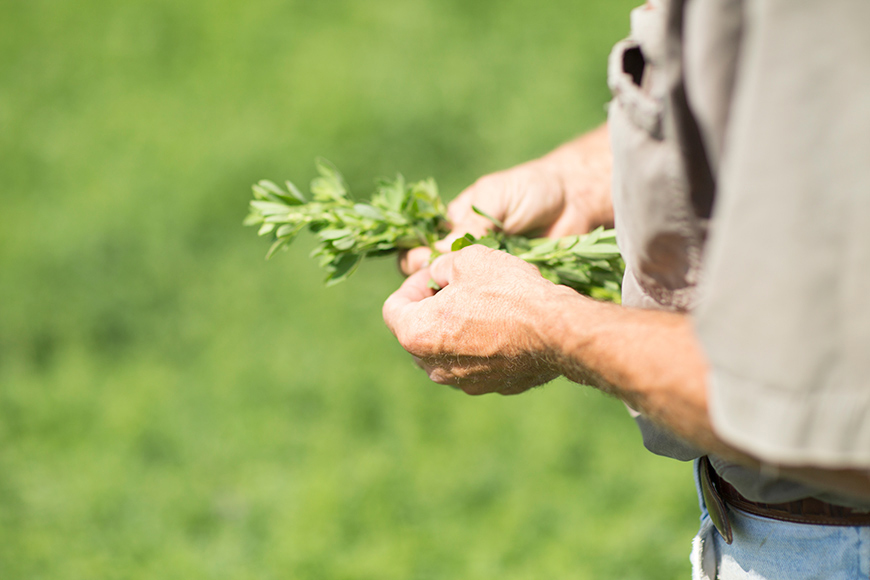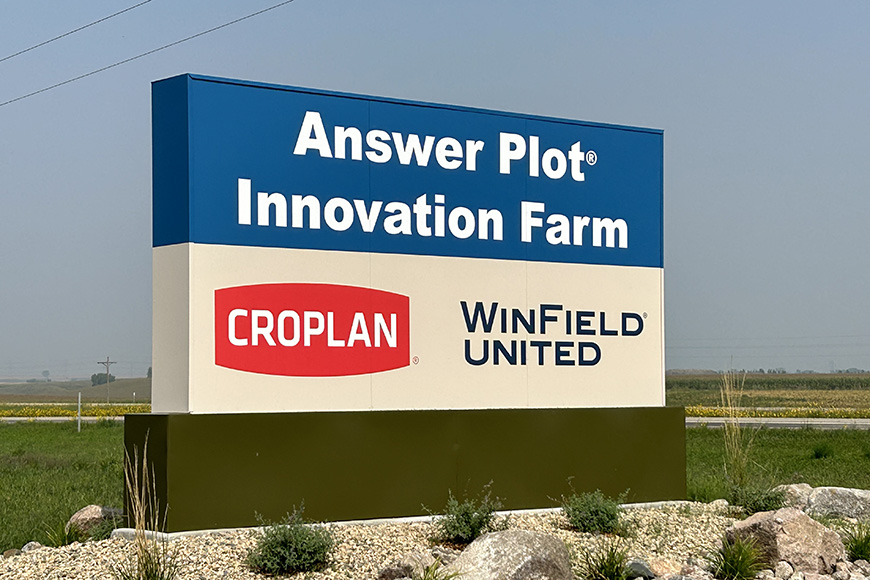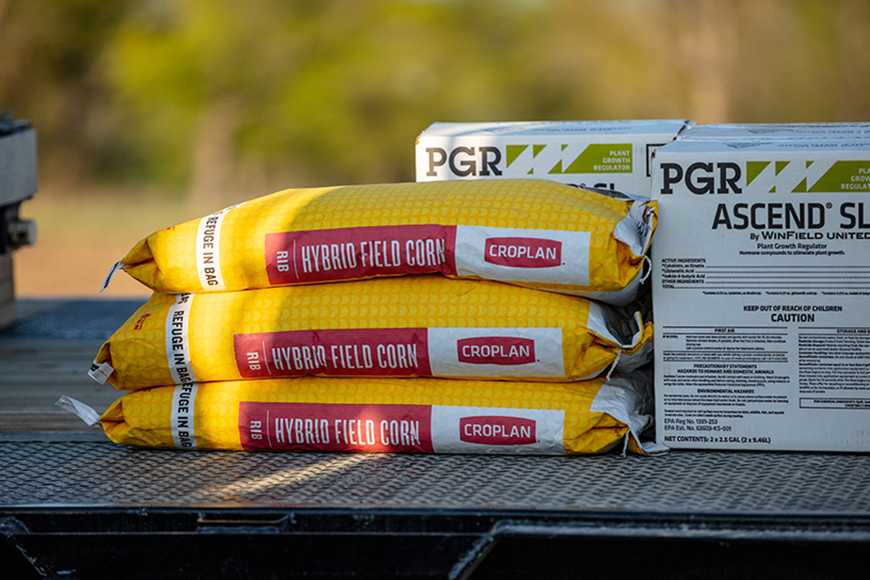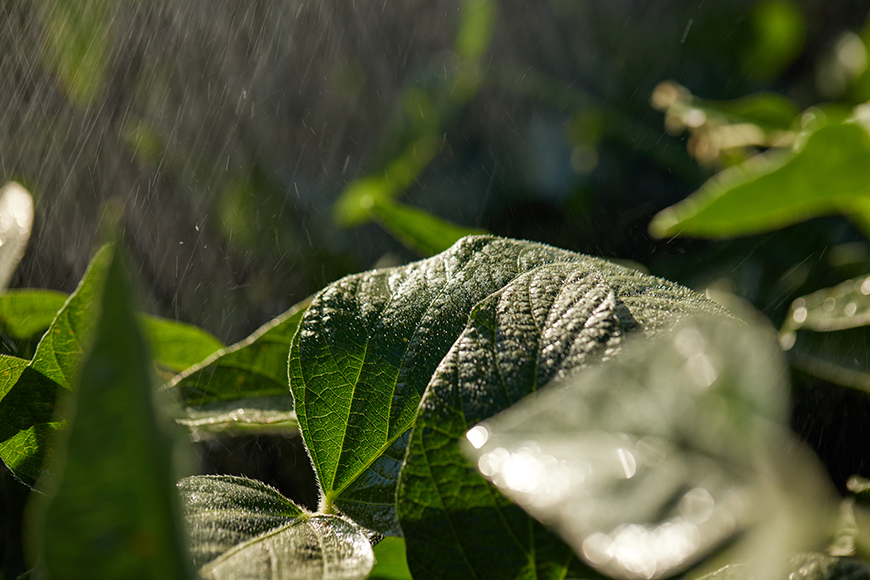Dec 01, 2021
TOPICS(S) | Agronomic Information, Seed
Alfalfa Seed Treatments Key to Long-term Stand Productivity
Cliff Watrin

Debates about uncoated, light-coated and heavy-coated alfalfa seed are common among seed providers and farmers. Skeptics say there tends to be less seed in a bag of coated seed and therefore farmers get less for their money. They may also claim coated seed requires increased seeding rates to achieve the same stand. However, research shows that coated seed can offer substantial benefits for an alfalfa crop.
As you’re weighing next season’s alfalfa seed decisions, here are five research-backed insights to consider that demonstrate the effectiveness of treated alfalfa seed.
Research by Purdue University shows coated seed produced as many seedlings per square foot as uncoated seed (29.5 and 30, respectively) when 21.8 lbs. of alfalfa seed was planted per acre (uncoated = 78 pure live seed [PLS] per square foot and coated = 56 PLS per square foot).1 The need for fewer seeds can mean reduced seed costs for farmers.
![]()
![]()
Coated seed increases seed efficiency by turning more seeds into healthy plants. Also, farmers generally plant more seed than is needed for a productive stand. Most plant more than 15 lbs. per acre, and some plant as much as 25 lbs. per acre. A 15-lb. per acre seeding rate at 200,000 seeds per pound (34% coating) is about 45 seeds per square foot. The goal is to have 15-20 established plants by fall of seeding year. Even at 15 lbs. per acre, there are more than double the seeds needed to establish a productive stand.
Work with your local WinField United retailer to find the right alfalfa seed option for your operation.
1. Alfalfa and Red Clover Stand Establishment. Forage Management Day at Feldun-Purdue Agricultural Center, Aug. 9, 2018.
2. Study by WinField United Innovation Center, River Falls, WI, 2018.
3. Study by Forage Genetics International, West Salem, WI, 2018.
All photos are either the property of WinField United or used with permission.
© 2021 WinField United. Important: Before use always read and follow label instructions. Crop performance is dependent on several factors many of which are beyond the control of WinField United, including without limitation, soil type, pest pressures, agronomic practices and weather conditions. Growers are encouraged to consider data from multiple locations, over multiple years and to be mindful of how such agronomic conditions could impact results. WinField is a trademark of WinField United. All other trademarks are the property of their respective owners.
As you’re weighing next season’s alfalfa seed decisions, here are five research-backed insights to consider that demonstrate the effectiveness of treated alfalfa seed.
1. Coated seed results in better stands.
Critics of coated seed recommend increasing seeding rates because fewer seeds are planted per square foot. However, coated seed actually has a higher seed-to-seedling success rate than uncoated seed so fewer seeds are needed to produce a similar stand.Research by Purdue University shows coated seed produced as many seedlings per square foot as uncoated seed (29.5 and 30, respectively) when 21.8 lbs. of alfalfa seed was planted per acre (uncoated = 78 pure live seed [PLS] per square foot and coated = 56 PLS per square foot).1 The need for fewer seeds can mean reduced seed costs for farmers.
2. Coated seed offers better seed-to-soil contact.
Large farm equipment or reduced tillage options may impact seedbed preparation, resulting in poor seed-to-soil contact. Coated seed offers better moisture absorption and transfer to the seed for germination. The coating material (often lime) attracts water better than the seed itself. This was verified by lab research from the WinField United Innovation Center, where 34% coated seed had about a 12% better germination rate than uncoated seed from the same seed lot.23. Coated seed provides greater protection against early-season pests.
In a study conducted by Forage Genetics International, two sets of three seed treatments (uncoated, 9% coated and 34% coated) were sampled and chemically analyzed for the fungicide active ingredient mefenoxam. In both cases, the rate of fungicide per seed was highest on the 34% coated seed and lowest on the uncoated seed. This makes sense, given that dose recommendations for alfalfa are based on weight, not seeds per pound (Figure 1).34. Alfalfa seedlings from coated seed have more vigor when disease is present.
Testing under multi-race Aphanomyces root rot disease pressure indicated 86% more lateral roots and 16% longer roots when seeds were treated with the fungicide active ingredient and coated compared with uncoated treated seed (Figure 2). GroZone® 34% coating provided an additional 12% increase in Aphanomyces root rot resistance over the standard 34% coating when comparing overall root health of the seedlings.35. Coating helps keep products close to the seed.
Experience has shown coating enhances the protective effect of the single fungicide active ingredient and suggests that inoculants, additional fungicides, plant growth regulators and micronutrients are also more effective on coated seeds. As other products are added to the seed treatment, it makes sense to use a coating to keep the beneficial products close to the seed.Coated seed increases seed efficiency by turning more seeds into healthy plants. Also, farmers generally plant more seed than is needed for a productive stand. Most plant more than 15 lbs. per acre, and some plant as much as 25 lbs. per acre. A 15-lb. per acre seeding rate at 200,000 seeds per pound (34% coating) is about 45 seeds per square foot. The goal is to have 15-20 established plants by fall of seeding year. Even at 15 lbs. per acre, there are more than double the seeds needed to establish a productive stand.
Work with your local WinField United retailer to find the right alfalfa seed option for your operation.
1. Alfalfa and Red Clover Stand Establishment. Forage Management Day at Feldun-Purdue Agricultural Center, Aug. 9, 2018.
2. Study by WinField United Innovation Center, River Falls, WI, 2018.
3. Study by Forage Genetics International, West Salem, WI, 2018.
All photos are either the property of WinField United or used with permission.
© 2021 WinField United. Important: Before use always read and follow label instructions. Crop performance is dependent on several factors many of which are beyond the control of WinField United, including without limitation, soil type, pest pressures, agronomic practices and weather conditions. Growers are encouraged to consider data from multiple locations, over multiple years and to be mindful of how such agronomic conditions could impact results. WinField is a trademark of WinField United. All other trademarks are the property of their respective owners.
IF YOU LOVE OUR INSIGHT, YOU’LL LOVE OUR ROI POTENTIAL
Every successful harvest starts with a seed. It just can't end there. Choose which high-performing seed products you’ll start with this season.






